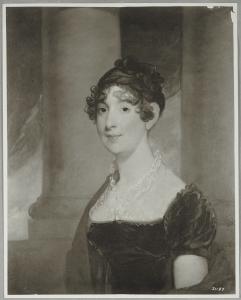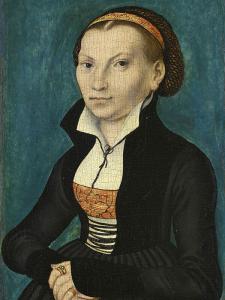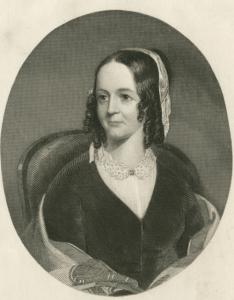 I am excited to welcome to the Anxious Bench for today’s guest post Samuel L. Young (PhD, Baylor University), a postdoctoral teaching fellow for Baylor’s Department of History. Young’s dissertation, “‘Saint of the Republic’: Martin Luther, Myth, and National Identity in Antebellum America” (May 2022), explores how early Americans used the long-deceased sixteenth-century German reformer to articulate what it meant to be a citizen of the new nation. Young was the 2021 recipient of the Sidney E. Mead Prize from the American Society of Church History and has published articles for Lutheran Quarterly and U.S. Catholic Historian, along with a forthcoming piece for Church History. In this post and one next month, he examines Luther’s complicated legacy for American women.
I am excited to welcome to the Anxious Bench for today’s guest post Samuel L. Young (PhD, Baylor University), a postdoctoral teaching fellow for Baylor’s Department of History. Young’s dissertation, “‘Saint of the Republic’: Martin Luther, Myth, and National Identity in Antebellum America” (May 2022), explores how early Americans used the long-deceased sixteenth-century German reformer to articulate what it meant to be a citizen of the new nation. Young was the 2021 recipient of the Sidney E. Mead Prize from the American Society of Church History and has published articles for Lutheran Quarterly and U.S. Catholic Historian, along with a forthcoming piece for Church History. In this post and one next month, he examines Luther’s complicated legacy for American women.
Martin Luther is having something of a moment. Since the 500th anniversary of the Protestant Reformation in 2017, there has been a trend among American academics, journalists, and writers to try to make sense of contemporary circumstances by looking back to the German reformer. Does Luther explain the rise of Donald Trump? Is he the progenitor of modern democracy and American liberty? Are today’s civil rights movements indebted to his life and work? Or as, Lutheran theologian Amy Marga recently asked, would you find “Martin Luther at the Women’s March?”
This is not the first time the United States has had a “Luther moment.” In the early decades of the nineteenth century, many Americans were convinced that Luther was a proto-American hero whose stand against a tyrannical Roman Catholic Church paved the way for the religious liberty, freedom of conscience, and representative government protected under the U.S. Constitution. The tying of Luther to the American founding became so cliche’ that an unhappy Roman Catholic bishop quipped in 1838 that you couldn’t go to any public gathering–Fourth of July, election day, graduation–without somebody singing the reformer’s praises. By 1850, Americans testified to this American Luther myth in their poetry, textbooks, sermons, songs, periodicals, speeches, and art.
The ubiquity of the American Luther myth meant that Americans could employ the reformer in debates over any number of cultural, social, and political questions. For instance, advocates of the widespread “cult of domesticity” (the notion that ideal femininity required pious service to husband and children in the home) used Luther and the Reformation as support for their views. Because of Luther’s opposition to convents and vows of celibacy, these readings of the reformer largely affirmed the Protestant Reformation as a liberation of women.
But these authors didn’t mean by women’s liberation what is often meant to today. They argued that, in his life and teaching, Luther had exalted women to their divinely appointed status as wives, mothers, and keepers of the home. As Marie Anne Pagliarini and Cassandra Yacovazzi have argued, Roman Catholicism, women religious, and vows of celibacy constituted unique threats to this conception of Protestant femininity. Catholicism relegated pious women to convents, denying them the glories of motherhood and condemning them to the imagined harm of lecherous priests, confessors, and mother superiors.
As a way to counter the competing Catholic conception of femininity, by the 1830s accounts of Luther’s life emphasized the effect of his Reformation on the lives of women. Antebellum authors brought attention to the women in Luther’s life, examined how the reformer’s teachings affected women, and explored how women participated in shaping the reformer. In these narratives, there was no ambiguity about the kind of femininity recommended by Luther. His teaching on motherhood and parenting–as well as his own marriage with Katharina–testified to the domestic life as the pinnacle of Protestant womanhood. This was one common example of how the Luther myth shaped American culture in the nineteenth century.

The first major Luther biography to incorporate female characters was Hannah Farnham Lee’s 1839 Life and Times of Martin Luther. Lee came from a wealthy Unitarian family in Boston and would go on to write several works of historical fiction, including volumes on the Huguenots and Thomas Cranmer. Her take on Luther’s life was decidedly dramatic: she scripted conversations between historical actors and added vivid descriptions of their thoughts and emotions. Though she assured her readers that this “more graphic” approach was all based on academic research and Luther’s writing, the final work more closely resembled an historical romance novel than a straightforward biography (i).
More significant than the form of her narrative was the way in which Lee altered the traditional structure of Reformation history by adding multiple female characters. Going beyond the sideline characters of previous histories, these women were principal actors in the story. The narrative revolves around the relationship of three couples: the highly embellished story of Count Albert of Mansfield and his wife Alice; Philip Melanchthon and his wife Margaret; and Luther and Katharina.
The events of the Reformation serve as a stage for the development of these three love stories. Alice lives tucked away in the Castle Wartburg, mourning the mysterious death of her parents. She submits herself to the mentorship of an old and corrupt Dominican, Father Francis. After meeting the young and handsome Count Albert–an early devotee of Luther’s Reformation–Alice’s bright and inquisitive mind begins questioning the overbearing and exacting theology of Father Francis. Unable to resist the priest’s manipulation, she spurns the overtures of Albert and the teachings of the Reformation by pledging herself to a convent. After several years of absence, Albert returns to the Wartburg, and their romance is rekindled. When Alice discovers that Father Francis had tortured and killed her parents as an Inquisitor, she renounces Roman Catholicism, escapes to Wittenberg, and marries Albert.
In her narrative, Lee attributed much of Luther’s early theological development to his relationship with Phillip Melanchthon and his wife Margaret. It was in observing their marriage that Luther, “witnessing this happy union” and “seeing every domestic virtue in beautiful exercise,” becomes fully convinced of the glories of marriage and the evil of clerical celibacy. Throughout the story, every major event or theological breakthrough for Luther is discussed in the Melanchthon home, in the company of Phillip and Margaret (106).

The Melanchthon home is also the setting for Katharina’s religious awakening. Lee cast the former nun as a tragic figure. Forced into a convent, her story is filled with conniving Mother Superiors preying on young nuns as their “pets” (118-19). Inspired by Luther’s actions, Katharina realizes the depths of her “superstition” and “darkness” of thought. Escaping to Wittenberg while Luther is in exile at the Wartburg, she stays with the Melanchthons and converts to the Protestant cause (125-28). After Luther returns to Wittenberg from his exile in the Wartburg, the Melanchthons set the couple up and they marry.
Immediately following their marriage, Lee narrated the domestic arrangement of the Luther home. The reformer’s quotes on love, home life, and family are peppered with Katharina’s responses and questions. While Luther complains about particular events or figures, she quietly listens, cooks, and picks him flowers. Whereas Luther had aided in the conversion of Katharina, Katharina was responsible for civilizing Luther:
The care of the house, of course, devolved on Catherine… The neat little parlour, with its windows shaded by vines instead of silken drapery, opened into a garden, where both she and Luther, like our first parents, cultivated the earth. Their table was supplied with vegetables from it… Nothing could be pleasenter than the dwelling and garden of Luther. In his household, with Catherine by his side, he was no longer the austere Saxon Reformer. Every object brought to his well-stored mind some pleasant thought or allegory; in the latter, he took great delight (206-7).
Katharina’s domestic prowess earned the respect of her husband; she was his “empress” in whom he delighted (211).
Lee’s narrative affirmed the notion of Protestant femininity as a two-fold liberation from the strictures and oppression of Roman Catholicism. First, the Reformation emancipated women to their rightful status as wife and keeper of the house. Every woman in Lee’s narrative that converts to Protestantism also gets married in the process. Katharina earns her husband’s respect and blesses him by keeping a well-ordered home.
Second, Lee presented the Reformation as an emancipation of women from the intellectual tyranny of Catholicism. Luther’s teachings become the basis for individual women to challenge the authority of corrupt religious leaders, and indeed, Lee argued that women were often more capable than men in exercising their curiosity and freedom of conscience in this way. This liberation of the intellect, however, had to be tempered by a deference to male authority. Female characters gain their freedom by submitting to Luther’s teaching, but Lee’s Luther chastises women for speaking out of turn and overstepping their position in the home. Melanchthon’s marriage turns dysfunctional due to Margaret’s “presentiments,” “delicate cast of mind,” and “ill-timed remarks”–domestic discord that disclosed a direct contrast to the harmonious relationship between Luther and Katharina (103-4, 287).
Lee’s Life and Times was the first of many publications that tried to inspire female readers to greater piety by giving greater attention to the women in Luther’s life. References to Katharina in these works contrasted her previous life in the convent to the liberation she found in marriage to the great reformer. Dependent entirely on Luther’s discussion of his wife in his letters and correspondence, such reconstructions of this sixteenth-century woman relied on determining the ways in which she had influenced Luther, and in turn, the ways Luther had shaped her. Like in Lee’s biography, this dynamic often narrowed descriptions of her virtues to her roles as wife and housekeeper.
Daniel Wise, a Methodist minister from Ohio, made this clear in the introduction to his 1849 piece on Katharina for the Ladies’ Repository. She belongs “in the ranks of superior women,” he argued, because she “made Luther happy in his domestic life.” Coaxed out of the tyrannical life of the convent by “the voice of Luther,” Katharina’s poise in domestic virtue became the basis for the reformer’s worldly successes. They had “truly a happy marriage,” Wise surmised, and “every Protestant heart owes Catharine grateful and affectionate remembrance, because she made Luther happy.“
Katharina’s relegation to Luther’s domestic shadow was especially clear in the first stand-alone biography published in the United States, John G. Morris’s 1856 Catherine De Bora. Morris, a Lutheran minister from Baltimore, spent the majority of his book focusing not on Katharina, but on the impact of marriage and parenthood on the Reformation. Morris’s work only discussed Katharina’s personal development and character in a single chapter, and even here he made clear that there was “nothing remarkably striking” in Katharina’s history “considered apart from her relation to her illustrious husband.” She had “no extraordinary talents,” read and wrote very little, and died poor. Katharina’s single point of pride was that “she possessed sufficient independence of mind to reject several brilliant offers of marriage” and commit herself to Luther. In this marriage, she was “a pattern of every domestic and Christian virtue” and Morris hoped that the “daughters and wives of the present day” would “imitate her example.” (120-25). In these accounts by Wise and Morris, Katharina’s honor depended solely on her role as wife to Luther, as mother to his children, and as administrator of his household.

Sarah Josepha Hale, editor of Godey’s Lady’s Book, offered a more nuanced portrait of Katharina in her 1853 Woman’s Record. Rather than extolling the former nun for her relationship with Luther, Hale judged Katharina as a noble figure well before–and independent of–her marriage with the reformer. After all, it was Katharina who boldly left the convent, and it was this “heroism” and “excellent qualities of mind and heart” that attracted Luther to the young woman. She was already an extraordinary figure, and she carried this depth of character into her marriage.
It was this self-evident caliber of his wife that became the source of Luther’s domestic joy. She was “modest and gentle, decent in her attire and economical in the house,” containing “all the hospitality of the German noblesse” but “without their pride.” After her husband’s death left their family in poverty, she proved her worth again by working tirelessly to support her children (86). Like Wise and Morris, Hale’s brief account of Katharina lauded the woman’s domestic skills and parental acumen but grounded these appreciations in a broader account of her piety and virtue–characteristics that pre-dated and outlasted her relationship to Luther.
All of these examinations of the women in Luther’s life emphasized the domestic and parental ideals of Protestant femininity. Indeed, the “liberation” of women in the Reformation was the necessary precondition for imbuing seemingly simple acts–marriage, rearing children, keeping home–with world-historical significance. Luther’s glorious legacy included, in part, his elevating of these feminine roles to their place of eminence. American women could look to him and the women around him for inspiration in their own efforts to fulfill their divine calling to love their husbands, raise their children, and keep their homes.
But this is not the whole story. As Beth Allison Barr has recently illustrated in her Making of Biblical Womanhood, the Reformation contained deep incoherences on these questions surrounding the roles, equality, and spiritual power of women. These discrepancies were not lost on antebellum readers. As I’ll discuss next month in part two of this piece, the identification of Luther as a liberator of women could go beyond the domestic realm. Some early woman’s rights activists looked to the reformer as an inspiration for expanding legal rights for women, but questioned whether Luther’s inauguration of Protestant femininity did more harm than good.












